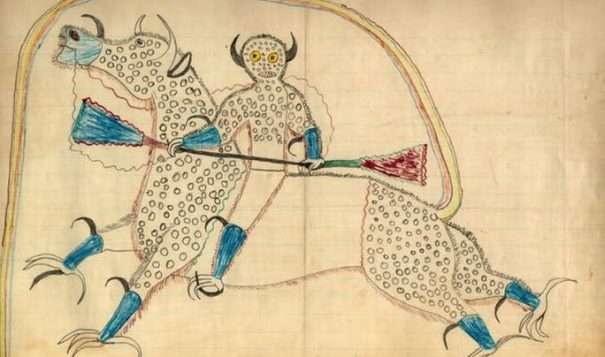 Ledger artwork by Lakota artist Black Hawk representing a dream of a thunder being. c.1880
Ledger artwork by Lakota artist Black Hawk representing a dream of a thunder being. c.1880
Indian Country Today
Now, some of you might have noticed that I am posting my Native Nerd column on Saturday. I post my column every Friday, but I wasn’t able to this week …why? Because as I was editing my weekly video news report, I heard a gigantic boom outside my window and lost all my power for several hours.
Side note, my Adobe Premiere Pro had JUST saved my video editing project, thus averting disaster. Shortly after my power was out, I heard sirens as if something pretty significant had happened. What was the culprit? A massive bolt of lightning had hit a powerline, or power structure of some sort.
So then I thought this morning, ‘Aha! Let’s talk about lightning on my Native Nerd column shall we?’
Let’s talk tradition first
From a Native perspective, there are a lot of traditional beliefs about thunder beings to include Thunderbirds, the Lakota people’s sacred clown people (who are more traditionally known as Heyoka) and other spirits among the sky.
There is of course the story of Lakota elder Black Elk, who described himself as a Heyoka, saying he had been visited as a child by the thunder beings.
Thunder beings, or the creatures, spirits and pranksters of thunder are believed to be both destructive as well as protective. As is the way of nature.
Take a look at this video by Choctaw elder Chief Walking Bear speaking about the Heyoka and how he himself experienced it firsthand. My mind was blown away.
So what about the science?
What exactly is lightning? Truthfully I had no idea other than I thought maybe clouds rubbed together and caused something similar to rubbing your feet on the carpet and shocking your brother by touching him with your finger.
As it turns out I wasn’t that far off.
I looked at the website Science Made Simple and this is the description they describe… I’ll summarize it a bit.
Water and ice move around inside the cloud they compress and form static electricity. The particles in the cloud become charged. Positive charges move up, and negatives move down.
So when this happens, the charge has to neutralize, and it zaps the ground to release the energy. A negative charge is what races down, and this giant spark, or lightning, heats the air to about 36,000 degrees farenheit.
Since the air heats so rapidly, the change in the air’s temperature creates a shock wave – thus the loud ‘boom’ of lightning.
The light is a million times faster than the sound. So if you want to figure out how far away a storm is, for every four seconds between the flash and the rumble, the thunderstorm is one mile away.
Since I experienced these two sounds yesterday simultaneously, I figure the storm was about a foot from my head.
Quick story, when I was a little boy of about four-years-old I was crying and super-scared of the thunder. The explanation to me as a kid? It was angels bowling. Of course I was immediately horrified thinking of massive bowling balls and bowling pins thrown by frightening giants with wings.
Thanks mom and dad for giving me a lifetime of trauma.
This is Vincent Schilling, proud Native Nerd and associate editor at Indian Country Today, Thanks for reading this week’s version of Native Nerd, check me out every Friday — weather permitting.
I’ll leave you with a video I made a few years back for my wife Delores, who loves rain and thunder.
Follow fellow Native Nerd, Vincent Schilling associate editor for Indian Country Today at @VinceSchilling
Make sure to use the Hashtag #NativeNerd
